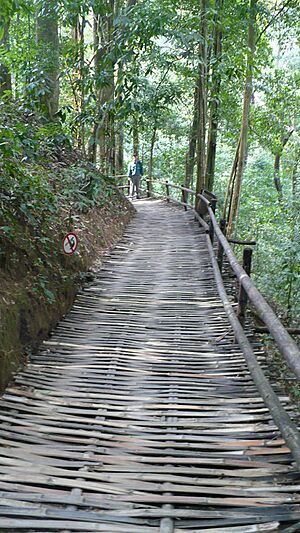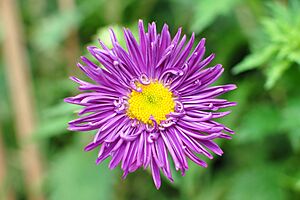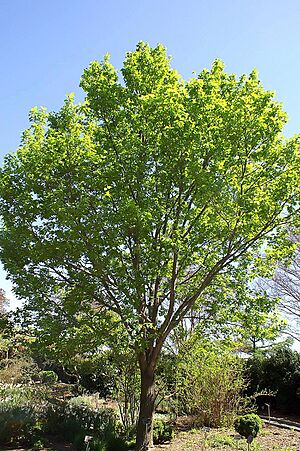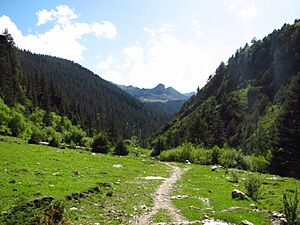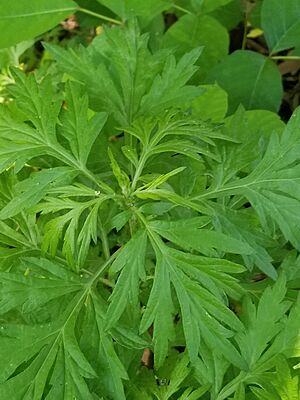Flora of China facts for kids

The flora of China means all the different kinds of plants that grow there. China is home to an amazing variety of plants, including over 39,000 types of vascular plants (plants with special tubes to carry water), 27,000 kinds of fungi (like mushrooms), and 3,000 types of bryophytes (small, simple plants like mosses). More than 30,000 plant species are native to China, which is about one-eighth of all plant species in the world! Many of these plants are found nowhere else on Earth. China is a huge country, covering over 9.6 million square kilometers. This large area has many different ecosystems and climates, like shores, tropical forests, deserts, high plateaus, and mountains. These different places create perfect homes for a wide range of plants.
Contents
What are Vascular Plants?
China has over 39,000 types of vascular plants. These include angiosperms (flowering plants), gymnosperms (plants with seeds not enclosed in an ovary, like pine trees), ferns, and fern allies (plants related to ferns). About 31,500 of these are native to China, and more than half are endemic, meaning they grow only in China. All these plants have been carefully recorded in a huge collection of books called the Flora of China (series).
Amazing Native Plants
The Asteraceae family, which includes the China Aster, is well-known in China. Many plants from this family have been used for medicine and as beautiful ornamental plants. The Callistephus, also called the Chinese Aster, is a common example that is native to China.
The Dawn Redwood (Metasequoia glyptostroboides) is a special tree that loses its leaves in winter, even though it's a conifer. It's native to the Hubei province in China. This tree is listed as a very rare and endangered species. People thought this type of tree was extinct until a group of them was found by scientists in Central China in 1948. Today, it's the only type of Metasequoia left, with only about 5,000 individual trees remaining in the wild.
The Gutta-percha tree (Eucommia ulmoides) is a small tree with leaves that fall off in winter. It's almost threatened in the wild. However, people in China grow it widely because its bark has medicinal properties. It's also important for China's natural rubber industry, as its leaves produce a rubbery substance when torn.
The Happy tree (Camptotheca acuminate) is a small tree that grows along warm, humid river banks near the Yangtze River. Its leaves, bark, roots, and seeds have been used in the past to treat common colds, liver problems, and skin conditions.
The Yunnan Cypress (Cupressus duclouxiana) is a type of conifer tree found only in the lower areas of Central China. This species is endangered because its natural home is being lost.
Other native plants include the Golden Larch (Pseudolarix kaempferi), the dove-tree (Davidia involucrata), China fir (Cunninghamia lanceolate), Fujian Cypress (Fokienia hodginsii), Tienchi Ginseng (Panax notoginseng), and Lycium chinense.
Fungi in China
China has a huge number of fungi, with over 27,000 different species. As of 2018, China has reported 1,789 types of edible fungi and 798 types used for medicine. Fungi have been a very important part of China's traditional plant use for thousands of years. They were used in Chinese herbal medicine, cooking, and culture. The first records of Chinese fungi were found in an ancient book from the second century, which mentioned 14 different types of fungi used as herbal medicines.
The way fungi are spread across China isn't even. For example, Northwest China, which is a large area, has far fewer types of fungi compared to the tropical regions of South-Central and Southwest China. These tropical areas are much smaller but have many more species. This difference might be because of the different amounts of rainfall and climate conditions in these regions.
Growing mushrooms plays a big role in China's economy and environment. Over 100 species of fungi are now grown by people, with about 60% being sold commercially. This provides food, income, and around 25 million jobs. China is now one of the biggest producers of edible mushrooms in the world, growing over 38 million tonnes each year.
Types of Plant Areas
Forests
China has six main forest regions: North, Northeast, Northwest, South Central, Southeast, and Southwest. The Northeast and Northwest regions have mountains and cold forests with conifer trees. These forests are home to animals like moose and Asiatic black bear, and about 120 types of birds. In some moist conifer forests, you can find thick patches of bamboo growing underneath the trees. In higher mountain areas, rhododendrons grow under juniper and yew trees.
The cold-temperate forests in northern Northeast China are made up of conifer trees that lose their needles in winter. You can also find dwarf forests and different types of spruce and birch trees here. The temperate mixed forests, which are the largest forest region in Northeast China, have a milder and wetter climate. This allows both evergreen conifer trees and deciduous broad-leaved trees (which lose their leaves) to grow together. These forests are important for timber production and are also where valuable medicinal plants like Panax ginseng grow.
Subtropical forests cover central and southern China and are home to an amazing 146,000 species of plants. South China gets a lot of rain and has long wet seasons, which is perfect for bamboo and rice. North China, however, gets less rain and has fewer types of plants. Tropical rainforests are found only in Yunnan and Hainan Island. Even though they are small areas, they contain a quarter of all the plant and animal species found in China.
The Southwest forest region includes Tibet, Yunnan, Guizhou, Sichuan, and Chongqing. This region has many valuable ancient trees, like the Ginkgo biloba. This tree is a "living fossil" that has been around since the Permian Era, millions of years ago. China's landscape has changed a lot over time due to tectonic plate shifts, which created the Himalaya Mountains and the Tibetan plateau. These changes also affected China's climate, leading to the deserts in the Xinjiang region and the dry climate in northern and northwestern China.
China's amazing plant diversity today can be linked back to the end of the last global ice age, about 13,000 years ago. A large part of China was not covered by thick ice like other parts of the world. This allowed many plant species from before the ice age to survive. The Southwest forest region was an important "refuge" during the ice age, which is why it still has such a high diversity of plants. Trees like Amentotaxus argoenia, Podocarpus spp, and Dacrydium pierrei, which originated millions of years ago, still grow there.
There are four main types of subtropical broad-leaved forests in Southwest China: semi-humid, monsoon, mid-montane, and typical broad-leaved forests. Trees like Cyclobalanopsis, Castanopsis, and Lithocarpus are common in these forests.
How Humans Use Plants
Over 10,000 plant species in China have been used by humans in different ways, mostly for medicine. Today, Chinese plants are sent all over the world to be studied, used for food, or included in traditional medicine. The Chinese medicinal plant Artemisia annua, also known as sweet wormwood, is one of the most famous plants from China. It has been used since ancient times to treat fevers and was even found to be a possible treatment for malaria in the 1970s.
Poaceae, also known as grasses, are a very important group of plants for China's economy. There are about 1,795 species of grasses in China. Some types of bamboo, like Phyllostachys heteroclada, were used to weave everyday items such as mats and children's toys.
Plants have also played a big role in China's history and culture. They are often used as symbols in art, buildings, and religion. Different plants can have different meanings depending on their features or even how their Chinese names sound. The paeony is one of the most popular flowers in Chinese culture. Its beauty symbolizes wealth, honor, and high social standing.
Research shows that many useful plants in China are also endemic (found only there) or threatened. For example, 3,552 (33%) of useful plants are endemic to China, and 1,353 of those are on lists of globally threatened species. These lists include the IUCN (International Union for Conservation of Nature) and CITES (the Convention on International Trade in Endangered Species of Wild Fauna and Flora).
Protecting China's Plants
Humans have greatly impacted the plants in China. Things like climate change and pollution have affected where plants can grow and how diverse they are. For example, fewer fungi are found in Central and Eastern China, where there is more farming and industry, and where natural homes for plants are destroyed. Recently, a small flower called Fritillaria delavayi, found in Southwest China, has been evolving to blend in with its surroundings to avoid being picked. This plant has been used for medicine for 2,000 years, and its demand has grown, causing the flower to develop grey and brown leaves to camouflage with rocky areas.
Conservation Efforts
In 2002, China supported the Global Strategy for Plant Conservation. This plan helps protect plants both in their natural homes (in situ) and in special gardens or seed banks (ex situ). To help with this, the Chinese Academy of Sciences (CAS) started a program to manage the ex situ conservation of native Chinese plants. Their 12 botanical gardens help with conservation, research, and teaching the public. They planned to create new gardens and improve existing ones across different regions of China.
In 2008, China's own Strategy for Plant Conservation was adopted. More than 3,000 nature reserves have been created, covering about 16% of China's land. These reserves protect over 85% of natural land ecosystems, 40% of natural wetlands, 20% of native forests, and 65% of natural plant communities.
Invasive Species
China has a long history of both accidentally and purposefully bringing in invasive species. Invasive species are plants or animals that are not native to an area and can cause harm to the environment. They are widespread in China. The fast growth of China's economy, trade, and transportation makes it easier for new invasive species to arrive. Areas with more people tend to have more invasive plants. China has tried to fight these harmful species by raising awareness, creating a database of invasive species, and monitoring them.
Ceratocystis fimbriata and Ragweed (Ambrosia spp.) are two invasive species that cause economic losses in farming. Ragweed is also a threat to public health and China's natural environment. Alligator weed (Alternanthera philoxeroides) is another invasive species that harms forests. Other damaging and widespread species in China include Amaranth (Amaranthus spp.), Crofton weed (Eupatorium adenophorum), and Spinyflower alternanthera (Alternanthera pungens).
|


